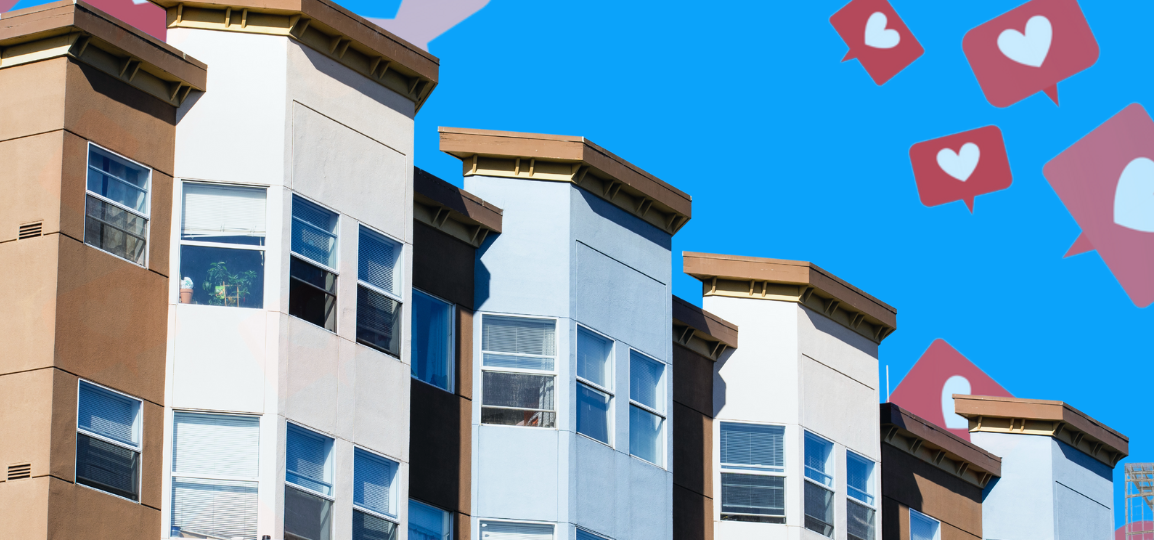
Last Updated on enero 10, 2025 by anytimedigital
As a multifamily unit marketer, you’re constantly looking for ways to attract new renters, engage current residents, and stay ahead of the competition. That’s where social media comes in. A powerful tool that can help you increase leasing, build a sense of community, and effectively target your ideal audience. By leveraging social media strategically, you can showcase your property’s best features. In addition, foster a sense of belonging among residents, and drive more leads to your doorstep. In this article, we’ll explore the most effective social media marketing strategies to help you achieve your goals and take your apartment marketing to the next level.
Visual Storytelling
High-Quality Photos and Videos
Virtual Tours and User-Generated Content
Visual storytelling goes beyond just showcasing your property’s features. It’s also about giving potential renters a sense of what it’s like to live there. Virtual tours are particularly effective for attracting out-of-town prospects who may not be able to visit in person. By creating a virtual tour, you’ll show what it’s like to walk through the doors and explore the community. With user-generated content, you can take your visual storytelling to the next level. Encourage your current residents to share their own photos and videos of their experiences living in your community. This could include snapshots of their favorite amenities, community events, or even just everyday life in their apartment.
By sharing this content on social media, you’ll create a sense of authenticity and trust with potential renters. With user-generated content, you’ll save time and resources on creating your own content. However, you’ll also tap into the power of social proof. When potential renters see real people enjoying life in your community, they’ll be more likely to imagine themselves living there too.
Resident Engagement
Community Events and Resident Spotlights
Events like holiday parties, charity drives, and outdoor gatherings are perfect opportunities to bring your residents together. Furthermore, create a sense of belonging. Promote these events on your social media channels to generate buzz and encourage attendance. Additionally, you can use social media to highlight resident spotlights, showcasing the unique personalities and stories of your residents. This not only creates a personal connection with your audience but also makes your property feel more like a community.
Maintenance Updates and Feedback Mechanisms
Any property manager knows that maintenance updates and feedback are crucial for keeping residents informed and happy. Social media provides an easy way to communicate with your residents about upcoming maintenance schedules, renovations, or other important updates. Moreover, you can use social media to gather feedback from residents, whether it’s through polls, surveys, or simple questions. This not only makes residents feel valued but also provides you with valuable insights into what they like and dislike about your property. With social media, you can quickly respond to resident concerns and address any issues that may arise. This helps to build trust and transparency. As a result, leading to higher resident satisfaction rates and reduced turnover.
Estrategia de contenido
There’s no one-size-fits-all approach to creating a successful content strategy for apartment and multifamily marketing on social media. However, by focusing on the right types of content, you can attract and engage with potential renters. Also, current residents, and local businesses. A well-planned content strategy should aim to educate, inform, and entertain your target audience, while also showcasing your property and its unique features.
Content Calendar and Consistency
Content calendars are important for maintaining a consistent online presence. In addition, ensuring that your social media channels remain active and engaging. By planning and scheduling posts in advance, you can save time, reduce stress, and ensure that your content is aligned with your marketing goals. Consistency is key to building trust and credibility with your audience. So, aim to post at least 3-5 times per week on each platform. Furthermore, by using a content calendar, you can track your performance, identify gaps in your content, and make adjustments to your strategy as needed. This will help you stay organized, focused, and committed to your social media marketing goals.
Educational Content and Local Information
Partnerships with Local Businesses
Local businesses can be a valuable resource for apartment and multifamily unit marketers. By partnering with local businesses, you can offer exclusive deals to residents, promote local events, and showcase the neighborhood. In addition, it can help you create engaging content. For instance, behind-the-scenes tours, interviews with local business owners, and promotions for new restaurants or shops. This type of content can help create a sense of community and make your property more appealing to potential renters.
For example, you could partner with a local gym to offer discounted memberships to residents. Or, collaborate with a nearby restaurant to provide exclusive discounts to residents. Do not forget, a successful content strategy is all about providing value to your target audience and showcasing your property in a unique way. By focusing on educational content, local information, and partnerships with local businesses, you can create a great content strategy that drives results and achieves your marketing goals.
Social Media Advertising
Targeting Prospective Renters
To effectively target prospective renters, you need to understand their demographics, interests, and behaviors. For example, you can target individuals based on their age, income level, occupation, and location. Additionally, you can target people who have shown interest in apartment living, moving, or local area information. By targeting the right audience, you can increase the chances of converting them into leads and eventually, residents.
Ad Formats and Lookalike Audiences
Renters are bombarded with ads on social media, so you need to make yours stand out. One way to do this is by using different ad formats. For example, carousel ads, video ads, and collection ads. These formats allow you to showcase your property, amenities, and neighborhood in a visually appealing way. As a result, increasing engagement and conversions.
Geo-Targeting and Ad Restrictions
Advertising on social media allows you to target specific geographic locations. Therefore, increasing the chances of reaching people who are interested in your apartments. For example, you can target people who live in a specific city, zip code, or radius around your property. This is especially useful for targeting local prospects who are more likely to be interested in your apartments.
However, it’s vital to be aware of ad restrictions on social media platforms, especially when it comes to housing ads. Facebook and Instagram have strict policies against discriminatory advertising. Therefore, you need to ensure that your ads comply with these policies. By understanding ad restrictions, you can avoid having your ads rejected and ensure that your marketing efforts are compliant.
Targeting specific geographic locations is crucial for apartment and multifamily unit marketing. By targeting the right audience, you can increase brand awareness, drive website traffic, and generate leads. Remember to be aware of ad restrictions and ensure that your ads comply with social media platforms’ policies.
Navigating Targeting Restrictions
Fair Housing Laws and Compliance
For instance, you must comply with fair housing laws that prohibit discrimination based on race, color, religion, sex, national origin, disability, and familial status. When creating social media ads, you cannot target or exclude audiences based on these protected characteristics. Ensure that your ads are inclusive and do not violate these laws.
Facebook and Instagram’s Targeting Options
Meta, Instagram and Facebook’s parent company, has implemented strict targeting restrictions for housing ads to ensure compliance with fair housing laws. You can no longer target ads based on age, gender, or zip code, and must avoid using language that could be perceived as discriminatory. Facebook and Instagram’s targeting options for housing ads are limited to location, interests, and behaviors. You can target people who have shown interest in apartments or multifamily units. Or, those who have recently moved or are planning to move. Be cautious when using these targeting options to avoid inadvertently excluding protected groups.
Measuring Success
Tracking Engagement and Conversions
With social media analytics tools, you can monitor engagement metrics such as likes, comments, shares, and saves. These metrics indicate how well your content is resonating with your audience. In addition, it can help you identify top-performing content types and topics. By tracking engagement, you can refine your content strategy to increase interactions and build a stronger online community.
Analyzing Ad Performance and ROI
One of the most critical aspects of measuring success is analyzing the performance of your social media ads. By tracking ad metrics such as click-through rates, cost per click, and conversion rates, you can identify which ads are driving the most value and optimize your ad spend accordingly.
To get a complete picture of your ad performance, you’ll need to track ROI, which will help you understand whether your ad spend is generating a positive return. According to a study by the National Multifamily Housing Council, for every dollar spent on social media advertising, apartment communities can expect an average ROI of $2.94. To accurately measure ROI, you’ll need to set up a system to track leads generated from your ads and attribute them to lease signings. This will enable you to calculate the revenue generated from social media advertising and compare it to your ad spend.
To wrap up
Hence, by now, you have an understanding of how to leverage social media for apartment and multifamily marketing. You’ve learned the importance of showcasing your property through high-quality visuals, engaging with current residents, and implementing targeted ads to attract prospective renters. By following these marketing tips and strategies, you’ll be well on your way to increasing leasing. In addition, building a strong online presence, and fostering a sense of community among your residents.

